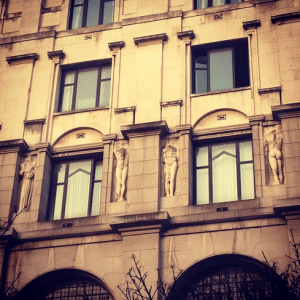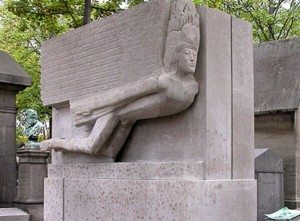Jacob Epstein and Sensational Art
Modernity and the Male Nude in Sculpture
One of the most promising and interesting artists of the new century was the Anglo-American artist, Jacob Epstein (1880-1959), until he simply ceased to be interesting. Although he had a long and successful career and was knighted by the British crown, Epstein, by all accounts, seems to have backed away from the twentieth-century and retreated into a watered down and acceptable modernism, placing him in the safe precincts of Henry Moore () and Barbara Hepworth (). Moore and Hepworth were always evolving artists who produced sculptures that were timely and compelling, and Epstein’s fame rested largely upon a few ambitious early works, his shocking series of human figures for the British Medical Association Building (1908), his tomb for Oscar Wilde (1912) and the very famous but greatly misunderstood, Rock Drill (1913). The dates of these works are instructive, for, as will be suggested, the sculptures for the Medical Association can be associated with Gustav Klimt, who was a nineteenth century artist, and the Rock Drill has been linked (incorrectly) to Marcel Duchamp who has been though of as the father of postmodernism. But Epstein’s problems with the new century lie with the problems of his chosen crafts, sculpture, a discipline that seemed to have no place in modern art.
By the middle of the nineteenth century, Charles Baudelaire, poet, art writer and sharp-eyed observer of the shifts of the art world, wrote “Pour- quoi la sculpture eat ennuyeuse.” If sculpture was boring in 1848, suffering from a Neo-Classical hangover, then fifty years later, it was difficult to know how to update it. To their credit, Picasso and Matisse attempted to move what was essentially a Greco-Roman tradition into a century without tradition as yet. Matisse’s series Back took twenty three years but he began just a year later than Epstein’s hospital series. In 1913, while Epstein was putting Rock Drill together, Picasso was making a group of remarkable cardboard fabrications, called “constructions.” Emerging out of Picasso’s monochromatic Cubist paintings, the constructions redefined three dimensional works and separated traditional representational sculpture from conceptual studies of how an object was experienced by its users. Therefore any artist who decided to go into sculpture was forced to modernize the genre which meant that one had to redefine its purpose, the solution found by Picasso.
Epstein, however, received a commission that forced him to do academic work, a frieze of figures for niches along the third floor of a building designed by architect Charles Holden who recommended the newly arrived American. The theme was both old and new: the Ages of Man and science, but old ways won out. No one was stuck by the irony of including female figures on the face of the building, no one was adult enough to not be upset with the sight of sculptural nudity, and no one was ironic enough to mention the presence of the Elgin Marbles at the British Museum, example of publicly nude sculptures. The titles were mild and inoffensive, Youth, Infancy, also known as The Newborn, Mentality, sometimes called The Brain), Chemical Research, Maternity, Primal Energy and Form Emerging from Chaos also called Matter. Victorian prudery had to be heard and there were the usual rumblings about naked men and naked women (and old men and women at that) three stories above the heads of the passersby on the Strand. Gustav Klimt might have heard echoes of this British version of the Viennese horror over his University paintings, but in fact the unsuitability of nude sculptures in modern public settings had been a problem for decades. The British Medical Association, apparently a progressive body for its time, stood up for its young artist and his inoffensive nudes, nakedness being the natural state of humans, especially those in the hands of the medical profession.

Jacob Epstein. Ages of Man (1908)
In 1908, these over life sized figures were entirely conventional, but these marble figures were nude in an age uneasy with the human body. Fellow sculptor, Henry Moore defended Epstein, and it seemed that the controversy died down, but the problems with the eight foot sculptures reemerged when the building was taken over by a regressive organization, High Commission of Southern Rhodesia (now called the Zimbabwe House) in 1923. The eighteen statues were immediately in peril but it took an incident in 1937 that permitted the colonial government to attack the sculptures–something fell off the building and landed in the street below. It has been written that a head of one of the statues hurt a pedestrian; it has been written that pollution was eroding the stone and making the figures disintegrate, endangering the public. The truth is slightly unclear–but the outcome is certain: the sculptures were attacked by the Rhodesians and all protruding elements were lopped off, in an act of vandalism. All that remains of the original concept is the plaster prototypes prepared by Epstein and the record an act of vandalism that could have been an anti-Semitic act by a racist regime on the eve of the Second World War.

Oscar Wilde (1854-1900)
Scandal seemed to follow Epstein and the consequences of doing nude public sculpture in the twentieth century reverberate to this day. The next interlude of fin-de-siècle consternation over male nudity took place in Paris, arousing concerns over the male member and homosexuality in the City of Light. Today we consider Oscar Wilde (1854-1900) the poet and playwright as the victim of a witch hunt, hunted down by a mob of English homophobes. Convicted of public indecency or the crime of being a homosexual, Wilde spent two years in jail, years that broke both his health and heart. Having served his time, the writer moved to Paris where he died three years later. Wilde was buried in a temporary plot in Père-Lachaise Cemetery, but the permanent site, paid for by his friends and supporters quickly became the destination for pilgrims, some of whom were lovers of literature, others were paying homage to a martyr. Clearly a memorial was necessary to pay an appropriate tribute to the fallen poet and once again Jacob Epstein was selected unexpectedly for the honor of creating a suitable tribute. The year was 1911 and his mentor Auguste Rodin died in that year, taking with him, nineteenth century sculpture. His student, Epstein was fresh off the Strand controversy and, or, but, like Rodin, he did not censor himself.

Jacob Epstein. Tomb of Oscar Wilde (193-14)
Inspired by the great Assyrian guardian statues, the winged lions with the faces of kings, Epstein carved a huge tomb statue of a winged young man, knees bent, legs folded, and arms stretched backwards against the rush of wind–he is not kneeling, he is flying. According to Ellen Crowell, an authority on the Tomb, the statute was transported to Paris in 1912 where,
the twenty-ton block of English stone—carved and chiseled into a strikingly stylized art-deco variation on a fantastical, male Sphinx—stands out like a sore thumb in a nineteenth-century cemetery whose sculptural aesthetic seems, to the modern visitor, overarchingly figurative and representational. It is precisely this aesthetic alterity that has, for one hundred years, prompted viewers to regard Epstein’s “Tomb for Oscar Wilde” as future-rather than past-oriented, more modernist than Victorian, a monument to enlightened pride rather than retrograde shame.
At the time, this work, like the Strand statues, to be an exemplary example modernism, a truly forward thinking work of the avant-garde. After all, Epstein was part of the London Group artists association and was affiliated with the most advanced artists in England. Indeed when Epstein previewed the sculpture in his studio, the British press and intelligentsia were struck by its modernity. As the Evening Standard and St. James’s Gazette reported proudly,
Seldom in this country are we permitted to see such a dignified piece of monumental sculpture as Mr. Jacob Epstein has carved for the tomb of Oscar Wilde…. It is not executed but conceived in stone..
But the Parisians were not particularly exorcised by the extent to which Epstein was “modern,” but were concerned about the appendage of the statue of the young male nude. One does not expect Sphinxes to necessarily be clothed, but given that this work should have been thought of as part of the New Sculpture movement, the nudity of this “Winged Demon-Angel” was also throughly modern. The face of the young man is archaic Green and Egyptian, with pouting lips and pointed chin. The combination of the ancient with the modern was in keeping with the Parisian art world which, like Picasso and Matisse, had gone back in time to “primitive” origins to revitalize the exhausted tradition of western art. Ancient artists and tribal peoples had never shirked from human genitalia, a common sight in their cultures, but the frank rendition of male anatomy alarmed the Parisians just as the Londoners before them had been outraged. Erected in the context of the recent ordeal of Wilde and his notorious trial, the winged young man was read by the writer’s admirers as either a “portrait” of the deceased or as a reminder of his many young male partners. Epstein’s work was understood as a frank and open assertion of male homosexuality–a very modern social position in itself.
One might expect the city of the can-can, a city teeming with sex traffic, to be more open-minded than the uptight metropolis of London. However, nothing causes the upright authorities to take quick action than the sight of an uncovered male member. The order of the Préfet of the Seine and the head of the École des Beaux-Arts was sent out to fashion some kind of fig leaf and someone was given the unenviable task of slathering the exposed genitalia with plaster, covering the offensive sight. The act of censorship happened even before Epstein had completed the finishing touches on the memorial. The eighteen figures of 1908 had been protected from such incursions by their height from the street, but the Winged Sphinx was at ground level, easily reached. Epstein had to witness at first hand the fear of full frontal male nudity, a fear still present in society today. He said, “Imagine my horror when arriving to the cemetery to find that the sex parts of the figure had been swaddled in plaster! and horribly.” Worse was to come, the tomb was covered with a tarpaulin, with a gendarme on patrol to prevent its removal. Although Epstein attempted to complete his work, he was not allowed to remove the cover. Without the artist’s consent, a bronze fig leaf was fixed to the offending member and the tarp was whisked away. The bronze butterfly covering did not last long, stolen by “a band of artists and poets from the Latin Quarter,” and the penis and testicles were soon revealed to the world, at which point, the Great War began and the authorities had better things to do with their time.

Lipstick Tributes to Oscar Wilde
After the War, the world had changed and Epstein’s statue was now quaint and old-fashioned and receded from art world concern. The tomb became a place of pilgrimage and thousands of fond fans of Wilde fondled the now exposed parts until they shone like jewels. According to urban legend, two (English) ladies, offended by the unseemly shine, attacked the hanging genitals of the unfortunate Sphinx and severed the penis, a strange impulse for 1960. Extant photographs of the original sculpture indicates that there was nothing offensive or even remotely obscene, but this sculpture had the power to move people very powerfully. Now shorn of its proud possession, the statue’s appeal only increased–coincidentally or not–and over the years, thousands of visitors began kissing its surfaces. According to Dalya Alberge writing for The Guardian, the fad for kissing the statue began in the 1990s, and over time the tomb became covered with lip imprints. The grease from lipstick forced the authorities to clean the surface, a process that was so rehabilitating to the work that it female admirers must kiss the plexiglass wall that shields the flying angel. The Irish had long since claimed their famous son and paid for the expensive restoration and for the protective barrier for the lower extremities.

In a postscript, it must be noted that Epstein was confounded, but not deterred, by the repeated vandalism and censorship of his male nudes. A few years before his death, he unveiled, so to speak, a new male nude, Liverpool Resurgent (1956). The resurgence refers to Liverpool’s recovery from the repeated bombings during the Second World War. The department store itself had been heavily bombed and post-war photographs show the building as a mere shell. For some reason, the silly statute with the silly name was positioned over the (John) Lewis’s Department store, presumably extorting shoppers to shop.

Liverpool Resurgent (1956)
Known by the unfazed inhabitants of Liverpool, the statue of a young nude male, who is waving his arms around, perhaps directing traffic, is known locally as “Swinging Dick” or “Dickie Lewis.” According to Alan Maycock, “It was pruriently alleged that showgirls would be unable to pass the naked figure and that young minds would be poisoned by the nudity.” Two years after the genitalia of the Oscar Wilde angel was lopped off, a local songwriter celebrated “Nobby Lewis,” claiming on behalf of the people of Liverpool, “We speak with an accent exceedingly rare, Meet under a statue exceedingly bare..” Currently the entire building is being renovated again and scaffolding protects the statue from harm. A sign fixed to the front of the statue reads, “Erected by Alstrad NSG.”

If you have found this material useful, please give credit to
Dr. Jeanne S. M. Willette and Art History Unstuffed.
Thank you.